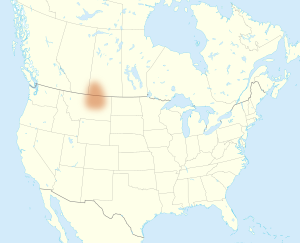Gros Ventre language facts for kids
Quick facts for kids Gros Ventre |
|
|---|---|
| 'ɔ'ɔ́ɔ́ɔ́naakíit'ɔ | |
| Native to | United States |
| Region | Montana |
| Ethnicity | Gros Ventre |
| Extinct | 2007, with the death of Theresa Lamebull |
| Language family |
Algic
|
| Official status | |
| Official language in | ( |

Historical extent of the language
|
|

|
|
Atsina, or Gros Ventre (also known as Ananin, Ahahnelin, Ahe, A’ani, and ʔɔʔɔɔɔniiih), was the ancestral language of the Gros Ventre people of Montana. The last fluent speaker died in 2007, though revitalization efforts are underway.
Contents
History
Atsina is the name applied by specialists in Algonquian linguistics. Arapaho and Atsina are dialects of a common language usually designated by scholars as "Arapaho-Atsina". Historically, this language had five dialects, and on occasion specialists add a third dialect name to the label, resulting in the designation, "Arapaho-Atsina-Nawathinehena". Compared with Arapaho proper, Gros Ventre had three additional phonemes /tʲ/, /ts/, /kʲ/, and /bʲ/, and lacked the velar fricative /x/.
Theresa Lamebull taught the language at Fort Belknap College (now Aaniiih Nakoda College), and helped develop a dictionary using the Phraselator when she was 109.
As of 2012, the White Clay Immersion School at Aaniiih Nakoda College was teaching the language to 26 students, up from 11 students in 2006.
Phonology
Consonants
| Bilabial | Dental | Alveolar | Palatal | Velar | Glottal | ||
|---|---|---|---|---|---|---|---|
| Plosive | plain | b ⟨b⟩ | t ⟨t⟩ | k ⟨k⟩ | ʔ ⟨’⟩ | ||
| palatalized | bʲ ⟨bʸ⟩ | tʲ ⟨tʸ⟩ | kʲ ⟨kʸ⟩ | ||||
| Fricative | θ ⟨3⟩ | s ⟨s⟩ | h ⟨h⟩ | ||||
| Affricate | ts ⟨c⟩ | tʃ ⟨č⟩ | |||||
| Nasal | n ⟨n⟩ | ||||||
| Approximant | w ⟨w⟩ | j ⟨y⟩ | |||||
Vowels
| Short | Long | |
|---|---|---|
| Close | ɪ ⟨i⟩ | iː ⟨ii⟩ |
| Mid | ɛ ⟨e⟩ | eː ⟨ee⟩ |
| Back | ɔ ⟨o⟩ | oː ⟨oo⟩ |
| ʊ ⟨u⟩ | uː ⟨uu⟩ |

